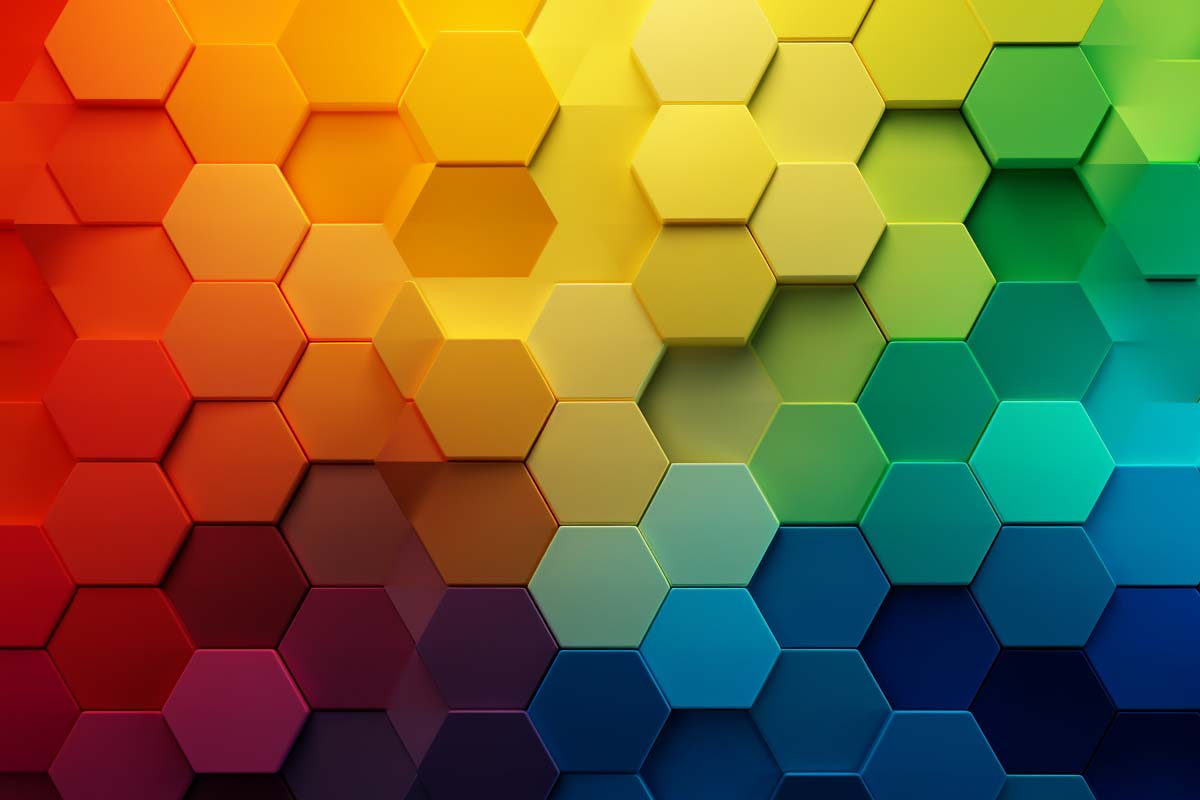Decoding HEX: The Color Language of the Digital World
In the vibrant universe of digital design, HEX codes are like the DNA of visual aesthetics. They’re not just random strings of letters and numbers; they’re the secret language of colors, translating binary computer speak into stunning visual experiences. As a digital artist, designer, or anyone dabbling in Adobe Creative Cloud, mastering HEX is like holding a key to an endless spectrum of creativity.
What Exactly is a HEX Code?
Picture a HEX code as a color’s unique fingerprint. In the world of HTML, HEX, short for hexadecimal, represents colors in a way that’s palatable for both humans and computers. Unlike RGB, which uses three numbers ranging from 0 to 255, HEX compresses this information into a more compact form, using numbers and letters (from 0-9 and A-F).
The Anatomy of a HEX Code
Imagine a HEX code as a short story with three main characters: R (Red), G (Green), and B (Blue). Each character has two digits dedicated to them in the format: #RRGGBB. These six characters define how much of each primary color is present. For example, #FF0000 is a tale where Red is the hero, dominating the scene with maximum intensity, while Green and Blue are mere spectators with zero presence.
HEX vs RGB: A Colorful Duel
The main difference between HEX and RGB lies in their usage. HEX is the go-to for web design, often preferred for its compactness, while RGB is more common in software interfaces. Though they speak different dialects, both tell the same color story.
Reading HEX: A Step-by-Step Guide
- Identify the Characters: Break down the HEX code into three parts: RR (Red), GG (Green), and BB (Blue).
- Convert to Decimal: Each pair of characters represents a number in hexadecimal. Convert them to decimal (e.g., A in HEX is 10 in decimal).
- Assemble the Puzzle: Combine these values to understand the color. For instance, #8B4513 translates to a rich, earthy brown, reminiscent of saddle leather.
Master Adobe with ITU
Explore ITU’s comprehensive Adobe courses and elevate your creative skills. From Photoshop to Illustrator, InDesign, and more, our expert-led tutorials are tailored for all levels. Whether you’re a beginner or a pro, ITU’s Adobe courses are your gateway to design mastery. Start your creative journey today!
HEX in Action: Visualizing Colors
Let’s decode #7DD0D7. The first pair, 7D, gives a mild intensity of Red. The D0 for Green indicates a stronger presence, and D7 for Blue suggests a similar intensity to Green. The result? A serene, greenish-blue hue, like a tranquil ocean.
Beyond Decoding: Crafting Color Schemes
Now, let’s take our HEX knowledge further. When building a color scheme, consider:
- Contextual Harmony: Colors should resonate with your project’s mood and message.
- Artistic Balance: Use color theory to select complementary, analogous, or contrasting colors.
- Creative Exploration: Don’t shy away from experimenting with shades and tints to find the perfect palette.
Harnessing the Power of HEX in Web Design
In the digital design realm, HEX color codes aren’t just about picking pretty colors; they’re the cornerstone of website aesthetics. For anyone venturing into HTML and CSS, understanding how HEX colors integrate into these languages is crucial. Let’s dive deeper into how HEX colors breathe life into web pages.
HEX in HTML: Setting the Stage
In HTML, HEX color codes are primarily used for defining the colors of different elements. Whether it’s the background of a page, the text color, or border hues, HEX codes ensure that the visual elements align with the desired aesthetic. For instance, <body style="background-color: #ff5733;"> sets the background color of a webpage to a vivid orange.
Common Colors Used In Web Design
| Color Name | HEX Code | Color Display |
| Black | #000000 | |
| White | #FFFFFF | |
| Dark Gray | #808080 | |
| Light Gray | #D3D3D3 | |
| Red | #FF0000 | |
| Green | #008000 | |
| Blue | #0000FF | |
| Navy Blue | #000080 | |
| Yellow | #FFFF00 | |
| Orange | #FFA500 | |
| Purple | #800080 | |
| Teal | #008080 | |
| Olive | #808000 | |
| Maroon | #800000 | |
| Fuchsia | #FF00FF |
The HTML 5 Color Picker
In HTML5, you can easily incorporate a color picker into your web page using the <input> element with the type attribute set to color. Here’s a basic example of the code:
<!DOCTYPE html><br><html><br><head><br> <title>HTML5 Color Picker</title><br></head><br><body><br> <h2>Select a Color:</h2><br> <input type="color" id="colorPicker"><br> <button onclick="showColor()">Submit</button><br><br> <script><br> function showColor() {<br> var color = document.getElementById("colorPicker").value;<br> alert("You selected: " + color);<br> }<br> </script><br></body><br></html><br>Select a Color:
In this example, the color picker is created with <input type="color" id="colorPicker">. When you select a color and click the “Submit” button, a JavaScript function (showColor()) is called. This function fetches the selected color value and displays it in an alert box.
This simple implementation demonstrates the use of the HTML5 color picker and how to retrieve its value using JavaScript. You can customize the behavior and appearance further based on your specific needs.
CSS: The Stylist of the Web
CSS takes HEX color usage to another level. Here, HEX codes are used not only for basic color assignments but also for creating gradients, shadows, and more. A CSS rule like color: #1e90ff; would give text a soothing blue tone, enhancing readability and visual appeal.
Opacity in CSS: The Art of Transparency
Opacity in CSS adds a layer of depth and subtlety to web designs. It allows designers to control how ‘see-through’ an element is. The opacity property ranges from 0 (completely transparent) to 1 (fully opaque). For example, opacity: 0.5; would make an element 50% transparent.
RGBA: HEX’s Cousin with Transparency Superpower
While HEX codes are great for solid colors, they don’t support transparency. Enter RGBA, a functional notation in CSS for colors with opacity. RGBA stands for Red, Green, Blue, and Alpha (opacity level). An RGBA color like rgba(255, 99, 71, 0.5) represents a semi-transparent red.

Lock In Our Lowest Price Ever For Only $14.99 Monthly Access
Your career in information technology last for years. Technology changes rapidly. An ITU Online IT Training subscription offers you flexible and affordable IT training. With our IT training at your fingertips, your career opportunities are never ending as you grow your skills.
Plus, start today and get 10 free days with no obligation.
Integrating Opacity with HEX Colors
While HEX itself doesn’t support transparency, you can achieve a similar effect by combining it with the opacity property in CSS. For instance:
.myElement {<br> background-color: #ff6347; /* Tomato red */<br> opacity: 0.6; /* 60% opacity */<br>}
Alternatively, CSS3 introduced a HEX notation that includes alpha values, known as HEXA. A HEXA color like #ff634780 represents the same semi-transparent tomato red, with the ’80’ indicating the alpha value.
Practical Applications: HEX and Opacity in Real-World Web Design
- Creating Overlay Effects: Use opacity to overlay text on images, ensuring readability while maintaining the visual context.
- Styling Hover States: Change the opacity of elements on hover to create interactive and engaging web experiences.
- Designing Modern UIs: Use subtle transparency in navigation bars and modals for a sleek, modern look.
In Conclusion: The Symphony of Colors and Transparency in Web Design
HEX colors and opacity in CSS are like the paint and brush strokes in an artist’s toolkit. By mastering these elements, you can create web designs that are not only visually stunning but also functional and user-friendly. Whether it’s setting the mood of a webpage or guiding the user’s eye, the thoughtful use of color and transparency can elevate your web design to new heights.
Frequently Asked Questions About A HEX Code
What Are HEX Codes in Design?
HEX codes are a six-digit, three-byte hexadecimal number used in web design to specify colors. Each pair of digits represents the intensity of the Red, Green, or Blue components of the color. Understanding HEX codes is essential for ensuring consistency and precision in digital design.
How Do I Choose the Right HEX Color for My Design?
Choosing the right HEX color depends on several factors like the desired mood, branding guidelines, and target audience. Tools like color pickers, palette generators, and design software can help you select and experiment with different HEX colors. Always consider color psychology and accessibility standards in your design process.
Can HEX Codes Be Used for Print Design?
HEX codes are primarily used for digital screens. For print design, CMYK color codes are more appropriate. However, designers often start with HEX codes and convert them to CMYK for print. Be aware that colors might look different on screen compared to when they are printed.
How Do HEX Codes Differ From RGB?
HEX codes and RGB values both represent the same thing—color. RGB uses decimal numbers (from 0 to 255) for Red, Green, and Blue, whereas HEX codes use a base-16 format. Essentially, HEX is a shorthand version of RGB, and they can be converted back and forth.
What Should I Consider When Using Multiple HEX Colors Together?
When using multiple HEX colors together, consider the harmony and contrast between the colors. Use a color wheel to understand complementary and analogous colors. Also, ensure there is enough contrast for readability, especially with text, and consider the overall aesthetic and emotional impact of the color combination on your target audience.

























